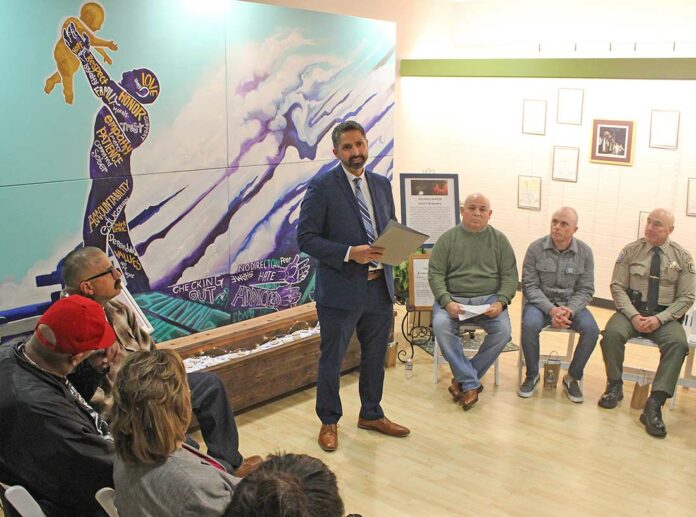
The Gilroy Reentry Resource Center is celebrating five years of providing crucial services to residents of south Santa Clara County who are leaving jail and prison, according to county staff.
Since 2018, the center has partnered with some of the county’s most effective programs designed to help individuals break the cycle of incarceration and find second chances for healthy, productive lives.
“One of the best ways to break cycles of incarceration is to provide services and resources throughout our county so individuals can easily access financial and social support when returning home from jail or prison,” said Supervisor Susan Ellenberg, President of the County of Santa Clara Board of Supervisors and member of the Santa Clara County Reentry Network, which advises the team governing the Reentry Resource Centers.
The board of supervisors earlier this year proclaimed April 2023 as Second Chance Month in an effort to highlight “the importance of addressing necessities of living to people who leave custody,” Ellenberg continued. “Without access to stable housing, food, clothing and opportunities to work or continue their education, the likelihood of returning to custody increases significantly. Investing in our reentry population serves not only to the direct benefit of the individuals served, but leads to reduced violence and anti-social activities, as well as increased employment in our communities—everyone benefits.”
The center opened as a pilot project in San Martin in 2015. It was later relocated to its current location at 8425 Murray Ave. in Gilroy in 2018.
While there are many resources accessible from this location, the most utilized are medical and psychiatric services from the weekly mobile medical bus, case management and wrap-around services provided by faith-based reentry programs, vouchers to obtain identification cards, employment information and referrals, and shelter information, county staff said.
“Providing these resources is the right thing to do to help our residents get back to productive lives, but it’s also a prudent way of saving our taxpayers’ money while improving public safety,” said County Supervisor Sylvia Arenas, whose district includes south Santa Clara County. “The expense of law enforcement, medical personnel and incarceration takes a huge financial toll on our community. Housing one person in jail for a year costs approximately $105,000. In many cases, we can save money and have a greater impact by reducing recidivism if we target root causes of incarceration, such as substance use addiction, mental illness, generational poverty and homelessness.”
A third of recidivism crimes are directly related to drugs and 20% of people in custody suffer from severe mental illness, according to the Office of Diversion and Reentry Services’ 10-Year Update in 2022. Substance use and mental illness often lead to homelessness, unemployment and, in many cases, recidivism. Coming home from jail or prison, 66% of South County Reentry clients have no permanent housing and 39% are unsheltered, while 72% are unemployed and 53% are looking for work.
“Connecting our residents who are leaving jail and prison with housing options, food assistance, medical care and employment opportunities is critical in helping them pursue healthier and more productive lives,” said County Executive Jeffrey V. Smith. “The county recently created a program to hire individuals who have an arrest or conviction on their records. This model of second chance employment helps individuals use their experience with the justice system to connect with and mentor other people reentering society from custody. This is what helps to break cycles of incarceration.”
Connection with a case manager who understands the challenges of reentry and can offer emotional support along with reentry resources is critical for clients, according to county staff. Charles, a former Reentry client, said when he was released after 25 years in prison, he felt out of touch with how to get along in the world. Through the Reentry Resource Center’s Good Samaritan Faith Based program, case manager Julian Delgadillo connected Charles, who is now 73, with a food bank, assistance with his utility bills and car registration, and helped him find a job that accommodates his physical disability.
Charles is now working and enjoying life with his wife in rural Gilroy.
“I can’t say enough about my case manager,” Charles said. “I was kind of out there lost a little bit and he stepped in. He checked on me every week to make sure I was OK.”
Building on its network of support for residents reentering the community, the Office of Diversion and Reentry Services continues to forge partnerships and initiatives with organizations like national venture philanthropy REDF, which is launching the Santa Clara County Regional Initiative for Social Enterprise (RISE), county staff added. RISE will create new employment social enterprises, which are businesses that provide jobs, training and support to people breaking through employment barriers.
“Our hope is to increase awareness of the challenges that reentry clients face and demonstrate the benefits of county support for programs like this,” said Javier Aguirre, Director of the Office of Diversion and Reentry Services. “With the community’s help, these collective efforts will help us invest more in the recovery and potential of our clients.”












